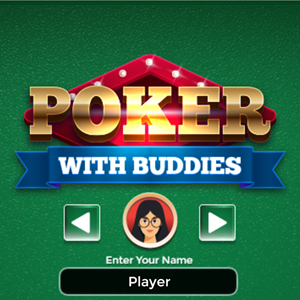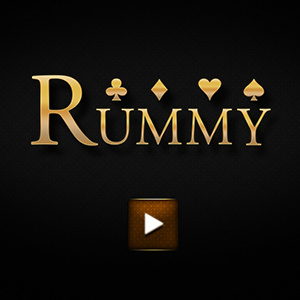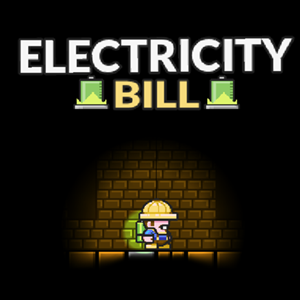Vegas Poker
This is a 5-stage Texas Hold’em Poker game where you play against 5 computer players.
- Bet to win and play your hands while maintaining enough chips to stay in play through the hand goal for each round.
- Boost your score by winning most or all of the chips in each round.
- Complete all 5 stages.
Play Vegas Poker Game Online
Children and parents can play this single player poker card game by clicking in the window below.

Alternatively kids and adults can play this Texas Holdem Poker video game versus the computer for free as a web application .
Vegas Poker Texas Hold’em Poker Game for Kids Video Game Play Instructions
How to Play
Play 5 levels of Texas Hold’em Poker against 5 computer players. Ensure you still have chips remaining at the end of each round to play the next round.
- Starting the Game
- Select the Play button on the game’s welcome screen.
- The welcome screen also has buttons for how to play help, high scores, and playing more games.
- The lower left corner of the welcome screen includes a language select dropdown.
- The lower right corner of the welcome screen offers buttons for social sharing & reading game developer info.
- Game Controls
- Desktop
- Use your mouse left click button to call, fold, check, go all in, or adjust raise amount then raise.
- Touchscreen devices
- Tap the on-screen buttons with a finger to use them.
- Controls & indicators
- The upper left corner of the game has buttons to pause the game or switch to full screen mode.
- The upper right corner of the game has buttons to control game music and sounds.
- Across the top it shows what level you are on, how many of the level hands you have played, and what your cumulative game score is from prior rounds.
- In the lower left corner of the game there are buttons to call, fold, check, or go all in.
- In the lower right corner there is a button to raise along with plus and minus buttons to adjust the amount you are rising.
- Chip counts: Slightly to the right of the center of the screen it show how many chips are in the pot. Near each player’s cards it shows how many chips the player has bet in the current hand. Off the table & near the player’s avatar their remaining chip count exclusive of the current bet is shown.
- Desktop
- Game Play
- Dealing & handmaking
- Texas Hold’em Poker deals each player 2 cards that only they can see.
- Up next is the flop, where three cards are dealt to the center of the table.
- Then there is the turn, where one more shared card is played to the center of the table.
- Finally comes the river, where a fifth shared card is dealt.
- Players can use any combination of the 5 best cards from the cards in their hand and the cards on the table to try to create a winning hand.
- At the end of each hand you have to click the Start new Round button in the center of the screen to deal the next hand.
- Betting
- The first level starts off with each of the 6 players getting 10,000 chips.
- The game starts with a small blind of 100 and a big blind of 200. This means before the deal two players need to bet at least that much before seeing their cards. Then everyone else can bet and players need to bet at least 200 after seeing their pocket cards to see the flop.
- After each round players can bet. If someone else raises your bet you can bet again. There is no limit to how much you can bet other than going “all in” by betting all of your chips.
- Betting types
- Check: match the bid of another if someone else raises. In the first round of a hand the check amount is the amount of the big blind unless someone else raises.
- Call: do not bet but stay in hand.
- Fold: leave the hand and forfeit any chips you put into the pot.
- Raise: similar to a check or call, but then you bid extra. When one player raises other players can choose to check or re-raise.
- All In: bet all your chips
- The button color will be blue if you can use that bet type & gray if you can not. The cost for calling is shown next to the call button.
- Game rounds
- This game has 5 levels.
- Each level has the following differences:
- 2 more required hands to play from 10 to 12 to 14 to 16 to 18
- small blind & big blind are increased by 100 and 200 respectively from 100 & 200 to 200 & 400 to 300 & 600 to 400 & 800 to 500 & 1,000
- the starting chip count for the level is increased by 2,000 from 10,000 to 12,000 to 14,000 to 16,000 to 18,000
- Your chips at the end of each round are added to your score total, but your chip count does not carry over into the next level.
- Dealing & handmaking
- Target Audience
- The game is suited for people of all ages who like poker video games.
- While the game involves gambling the chips are not real money chips, the chips are free & players do not play against one another but the computer.
- The game has no adult themed content.
- The game is suited for people of all ages who like poker video games.
Hand Probabilities
Starting Odds for Hold Cards
- 5.8% (or 1 in 17) of hands will be dealt a pair
- 23.5% of hands will start off suited
- 70.6% of hands will start off offsuit
Breaking things down more specifically…
- 1 in 331 hands will be dealt same suit ace-king
- 1 in 221 hands will be dealt pocket aces
- 1 in 81 hands will be dealt out of suit ace-king
- 1 in 41 hands will be dealt a top 5 pair (e.g. pairs of tens or better)
- 1 in 5 hands will be dealt connecting cards
7 Card Poker Probabilities
The following table highlights the random odds of any hand type in a 7-card poker game.
| Poker Hand | Frequency | Probability | Cumulative | Odds against |
|---|---|---|---|---|
| Royal flush | 4,324 | 0.0032% | 0.0032% | 30,939 : 1 |
| Straight flush (excluding royal flush) | 37,260 | 0.0279% | 0.0311% | 3,589.6 : 1 |
| Four of a kind | 224,848 | 0.168% | 0.199% | 594 : 1 |
| Full house | 3,473,184 | 2.60% | 2.80% | 35.7 : 1 |
| Flush (excluding royal flush and straight flush) | 4,047,644 | 3.03% | 5.82% | 32.1 : 1 |
| Straight (excluding royal flush and straight flush) | 6,180,020 | 4.62% | 10.4% | 20.6 : 1 |
| Three of a kind | 6,461,620 | 4.83% | 15.3% | 19.7 : 1 |
| Two pair | 31,433,400 | 23.5% | 38.8% | 3.26 : 1 |
| One pair | 58,627,800 | 43.8% | 82.6% | 1.28 : 1 |
| No pair / High card | 23,294,460 | 17.4% | 100% | 4.74 : 1 |
| Total | 133,784,560 | 100% | — | 0 : 1 |
Since players share cards on in Texas Holdem the odds of certain hand combinations are higher. For example, if the table is showing 3 8s then there is a higher chance of a competitor having 4 of a kind or a full house than whatever the random odds would be since they too have that 3 of a kind in their hand. The odds of two players both having a straight or flush would be elevated as well if many of the key cards that make up the combination are on the table.
Shorthand Ranking Systems for Playable Texas Hold’em Hands
Hand rankings have a lot of value for limit play, however in no limit play their value deteriorates quickly as the downside of “all in” is an exit from the game. Here are some notable ranking systems.
Sklansky Hand Groups
David Sklansky and Mason Malmuth created a diagram suggesting when hands should be played, with stronger hands having a lower number.
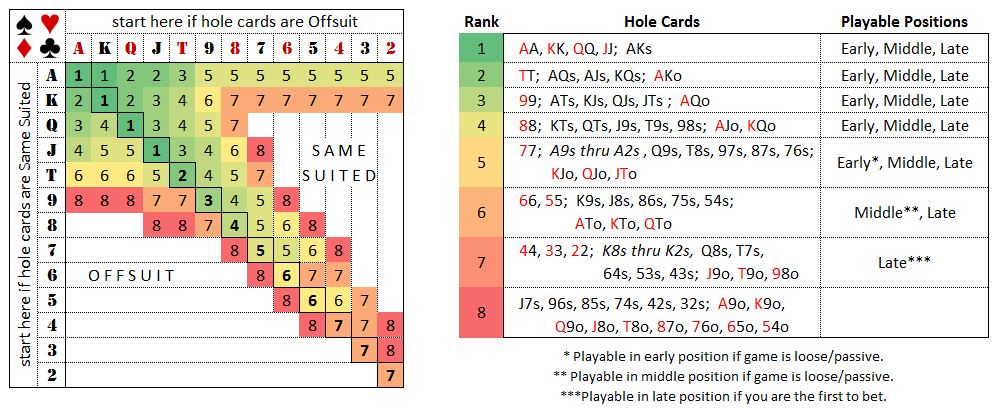
Phil Hellmuth
Similarly, Phil Hellmuth’s 2003 book Play Poker Like the Pros grouped hands by tiers.
| Tier | Hands | Category |
|---|---|---|
| 1 | AA, KK, AKs, QQ, AK | Top 12 Hands |
| 2 | JJ, TT, 99 | Top 12 Hands |
| 3 | 88, 77, AQs, AQ | Top 12 Hands |
| 4 | 66, 55, 44, 33, 22, AJs, ATs, A9s, A8s | Majority Play Hands |
| 5 | A7s, A6s, A5s, A4s, A3s, A2s, KQs, KQ | Majority Play Hands |
| 6 | QJs, JTs, T9s, 98s, 87s, 76s, 65s | Suited Connectors |
Chen Formula
Bill Chen developed what he called the “Chen Formula” which assigns points as follows
High Card
- Ace = 10
- King = 8
- Queen = 7
- Jack = 6
- 10 = 5
- 9 = 4.5
- 8 = 4
- 7 = 3.5
- 6 = 3
- 5 = 2.5
- 4 = 2
- 3 = 1.5
- 2 = 1
Pairs
Multiply the points by 2. A pair of aces would be worth 20, a pair of kings would be worth 16, and the minimum value for a pair is 5.
Suited
If cards are of the same suit add 2 points as you are more likely to be able to get a flush.
Closeness
This is given weight based on the probability you may be able to get a straight.
- Add an extra point if your cards are connected or a 1-gap and your highest card is below a queen.
- Subtract a point if there is a number between your cards (e.g. the king is between an ace and a queen).
- Subtract 2 points if there are 2 numbers between your cards.
- Subtract 4 points if there are 3 numbers between your cards.
- Subtract 5 points if there are more than 3 numbers between your cards (as you won’t be able to use both of your cards as part of a straight).
After the flop you then have to shift your approach based on the cards on the table.
Hand Strength and Tie Breakers
The strength of hands is as follows:
- Royal Flush
- Straight Flush
- Four of a Kind
- Full House
- Flush
- Straight
- Three of a Kind
- Two Pair
- Pair
- High Card
The approximate odds of various hands was shown above in the 7-card poker section, though the odds of rarer hands could technically be experienced more commonly in texas hold’em (particularly limit play) as players are not committed to throw away cards in order to see additional cards. A player could make a straight or a flush on the final card when they may not have played those cards in a 7-card game where they were forced to throw away a pair in order to make a flush or straight. Here are the odds using a 7 out of 52 hand where you get to make your 5 cards from a group of 7 you hold.
| Hand | Example Cards | Possibile Combos | Probability | Odds |
|---|---|---|---|---|
| Royal Flush |  |
4,324 | 0.003232062% | 30,939:1 |
| Straight Flush |  |
37,260 | 0.027850748% | 3,589.57:1 |
| Four-of-a-kind |  |
224,848 | 0.168067227% | 594:1 |
| Full House |  |
3,473,184 | 2.596102271% | 37.52:1 |
| Flush |  |
4,047,644 | 3.025494123% | 32.05:1 |
| Straight |  |
6,180,020 | 4.619382087% | 20.65:1 |
| Three-of-a-kind |  |
6,461,620 | 4.829869755% | 19.7:1 |
| Two pair |  |
31,433,400 | 23.49553641% | 3.26:1 |
| Pair |  |
58,627,800 | 43.82254574% | 1.28:1 |
| High card |  |
23,294,460 | 17.41191958% | 4.74:1 |
If two players have the exact same hand then the pot is split. If both hands are quite similar then the card value of the most important piece determines the winner. For example, if 2 players have a full house then whoever has the higher 3 of a kind wins. And if the 3 of a kind is the same for both players then whoever has the highest pair wins. For flushes or straights whoever has the highest card as part of that sequence wins. For games where both players have the same 4 of a kind, 3 of a kind, pair, etc. … then the remaining high card the player hold determines who wins.
The Flop
Many great hands are made on the flop between the cards in player’s hands and the cards on the flop. The flop by itself typically does not have much in the way of playable cards in absolute isolation. Typically the flop by itself (without the cards in player’s hands) is rather pedestrian. On the flop most the time cards are not connected, no pairs are shown, and there are rarely more than 2 cards in the same suit.
| Flop Cards | Probability | Odds |
|---|---|---|
| Three-of-a-kind | 0.24% | 415.67:1 |
| Pair | 16.9% | 4.91:1 |
| 3 suited cards | 5.17% | 18.34:1 |
| 2 suited cards | 55% | 0.82:1 |
| Rainbow | 39.8% | 1.5:1 |
| 3 connected straight cards | 3.45% | 27.99:1 |
| 2 connected straight cards | 40% | 1.5:1 |
| No connected cards | 55.6% | 0.799:1 |
The following table shows your probability of various hand improvements on the flop given a specific set of pocket cards.
| Pocket hand | Flop Improvement | Probability | Odds |
|---|---|---|---|
| Pair | Three-of-a-kind or better | 12.7% | 6.9:1 |
| Pair | Three-of-a-kind | 11.8% | 7.5:1 |
| Pair | Full house | 0.73% | 136:1 |
| Pair | Four-of-a-kind | 0.24% | 415.67:1 |
| 2 unpaired cards | Pair | 32.4% | 2.1:1 |
| 2 unpaired cards | Two pair | 2% | 48.5:1 |
| Suited cards | Flush | 0.842% | 118:1 |
| Suited cards | Flush draw | 10.9% | 8.17:1 |
| Suited cards | Backdoor flush draw | 41.6% | 1.4:1 |
| Connectors 45o-JTo | open ended straight draw | 9.6% | 9.42:1 |
| Connectors 45s-JTs | Straight draw / flush draw |
19.1% | 4.21:1 |
| Connectors 45o-JTo | Straight | 1.31% | 75:1 |
The Turn
After the flop comes the turn. The following table shows the odds of upgrading your hand on the turn.
| Current Hand | Turn Goal | Probability | Odds |
|---|---|---|---|
| Flush draw | Flush | 19.1% | 4.24:1 |
| Open ended straight draw | Straight | 17% | 4.9:1 |
| Gutshot straight draw | Straight | 8.5% | 10.76:1 |
| Three-of-a-kind | Four-of-a-kind | 2.1% | 46.61:1 |
| Two pair |
Full house | 8.5% | 10.76:1 |
| Pair | Three-of-a-kind | 4.3% | 22.26:1 |
| Two unpaired cards | Pair with a hole card | 12.8% | 6.8:1 |
The River
After the turn comes the river. The following table shows the odds of upgrading your hand on the river.
| Current Hand | River Goal | Probability | Odds |
|---|---|---|---|
| Flush draw | Flush | 19.6% | 4.1:1 |
| Open ended straight draw | Straight | 17.4% | 4.74:1 |
| Gutshot straight draw | Straight | 8.7% | 10.5:1 |
| Three-of-a-kind | Four-of-a-kind | 2.2% | 45.46:1 |
| Two pair |
Full house | 8.7% | 10.5:1 |
| Pair | Three-of-a-kind | 4.3% | 22.26:1 |
| Unpaired cards | Pair with hole card | 13% | 6.7:1 |
Understanding Outs
Each Texas Holdem hand has an “ideal” or best outcome available to it based on how things look after the flop.
After you have seen the flop and the cards in your hand you may need 1 card to complete a flush, a straight, a full house, a 3 of a kind, etc.
What you do is figure out how many cards from the deck remain and how many would satisfy your best hand.
For example, if you have 2 clubs in your hand and 2 clubs are showing on the table that means 4 of the 13 clubs are already gone, so there are 9 remaining clubs.
Each deck has 52 cards. You know what the 3 cards on the flop were as well as the 2 in your hand, so if you subtract those 5 cards that means there are 47 left. On the turn you would have a 9 in 47 (or 19.1%) chance of getting another club. If that card was not a club you would have a 9 in 46 (or 19.6%) chance on the river.
| Outs | Odds After Flop | Odds After Turn |
|---|---|---|
| 1 | 4.4% | 2.2% |
| 2 | 8.4% | 4.3% |
| 3 | 12.5% | 6.5% |
| 4 | 16.5% | 8.7% |
| 5 | 20.3% | 10.9% |
| 6 | 24.1% | 13% |
| 7 | 27.8% | 15.2% |
| 8 | 31.5% | 17.4% |
| 9 | 35% | 19.6% |
| 10 | 38.4% | 21.7% |
| 11 | 41.7% | 24% |
| 12 | 45% | 26.1% |
| 13 | 48.1% | 28.3% |
| 14 | 51.2% | 30.4% |
| 15 | 54.1% | 32.6% |
| 16 | 57% | 34.3% |
| 17 | 59.8% | 37% |
| 18 | 62.4% | 39.1% |
| 19 | 65% | 41.3% |
| 20 | 67.5% | 43.5% |
Combining Flop & River Odds
Below are the odds of completing common card scenarios on the turn, river, or across both.
| Hand | Outs | Flop to Turn | Turn to River | Turn + River | Odds |
|---|---|---|---|---|---|
| Pocket pair to 3 of a kind | 2 | 4.3% | 4.3% | 8.4% | 10.9:1 |
| Pair to 4 of a kind | 1* | – | – | 0.09% | 1,100:1 |
| Completing a pair of a high card | 3 | 6.4% | 6.5% | 12.5% | 7:1 |
| Completing a pair of either high card | 6 | 12.8% | 13.0% | 25% | 3:1 |
| Inside (gunshot) straight draw to straight | 4 | 8.5% | 8.7% | 16.5% | 4.88:1 |
| Two pair to full house | 4 | 8.5% | 8.7% | 16.5% | 4.88:1 |
| Two overcards to overpair | 6 | 12.8% | 13% | 24.1% | 3.15:1 |
| 3 of a kind to 4 of a kind | 1 | 2.1% | 2.2% | 4.3% | 22.26:1 |
| 3 of a kind to full house or 4 of a kind | 7 | 14.9% | 15.2% | 27.8% | 2.60:1 |
| Open ended straight draw to straight | 8 | 17% | 17.4% | 31.5% | 2.13:1 |
| Flush draw to flush | 9 | 19.1% | 19.6% | 35% | 1.86:1 |
| Backdoor flush draw to flush | 1* | – | – | 4.2% | 22.8:1 |
| Inside straight and flush draw to straight or flush | 12 | 25.5% | 26.1% | 45% | 1.22:1 |
| Open ended straight and flush draw to straight or flush | 15 | 31.9% | 32.6% | 54.1% | 0.85:1 |
* Rather than there being multiple outs, you need 2 consecutive cards to go your way. Individual odds not shown for flop and turn since you need both to go your way.
Understanding Pot Odds
When deciding if it makes sense to play you not only have to consider the odds of victory, but also the size of the pre-existing pot and the amount your competitor bet. If the raise was small relative to the pot size then you have to factor in the larger potential upside of winning the larger pot against the downside of the smaller incremental raise.
- Betting on 1 in 3 Odds: For example, if a pot is $200 and another player raises $20 and you have a 1 in 3 chance of hitting your out then it makes sense to bet as your upside is 10x the side of the bet and you have a 1 in 3 chance of hitting it.
- Not Betting on 1 in 3 Odds: Flipping things around, if the pot size was $200 and another player raised $300 then the 1 in 3 chances of hitting your out are less appealing since your upside would be less than you were wagering and your odds of hitting are below 50%.
The above is purely mathematical in terms of considering probability on a particular bet. There are also human emotions, bluffing, re-raising a raise, and many other factors to consider which makes poker a complex game beyond the math aspect of pot odds.
Winning at poker is not only figuring your odds of hitting what you want, but also if an opponent have almost the same hand with a higher kicker or if the shared cards which enabled your great hand enabled some other better hand for them.
Where & When Are the Key Cards Located?
If you are holding 2 pocket spades and you get a flush on the turn or river and there are only a total of 3 spades showing on the table the odds of someone else having a spades flush are low.
If, however 4 spades are on the table and many players are still in the game it is likely one of the competing players also has a flush, so in that case it matters what spade you have in your hand. If you have a 2 or a 4 and they have a facecard you will lose.
Most players may bail on a potential flush if they only have 1 card in their hand, get 2 on the flop and need both the turn and river to be of that same suit. If, however, the flop itself has 3 of the same suit there are likely to be other players holding a spade who stayed in the game hoping on a fifth spade.
The above sort of thinking is also true with a straight. If you have an outside straight and your card is to the low side there is a good chance a competing player has an outside straight with a higher top card than you do.
The same sort of thinking is true if you flop a 3 of a kind where 2 of the pair are on the flop. Someone else playing may have the 4th of that card & they might also have a higher high card than you do or a full house with a higher second card. If you flop a 3 of a kind with all 3 being on the flop there is a good chance someone else will have a 4 of a kind or a full house with another pair.
Like This Game? Review This Texas Hold Em Poker Video Game for Young Girls & Boys
Free Online Vegas Poker Video Game for Children & Adults Screenshots
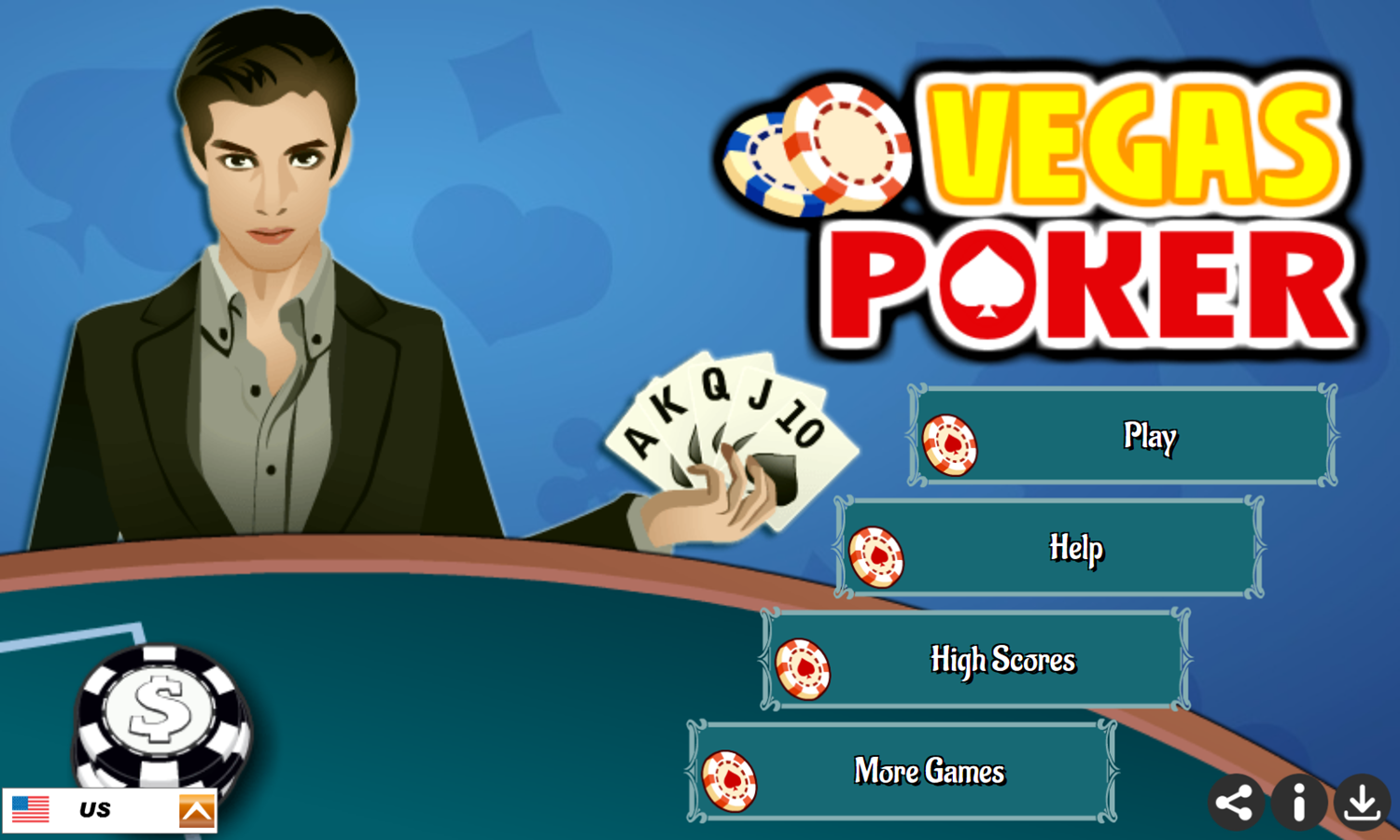
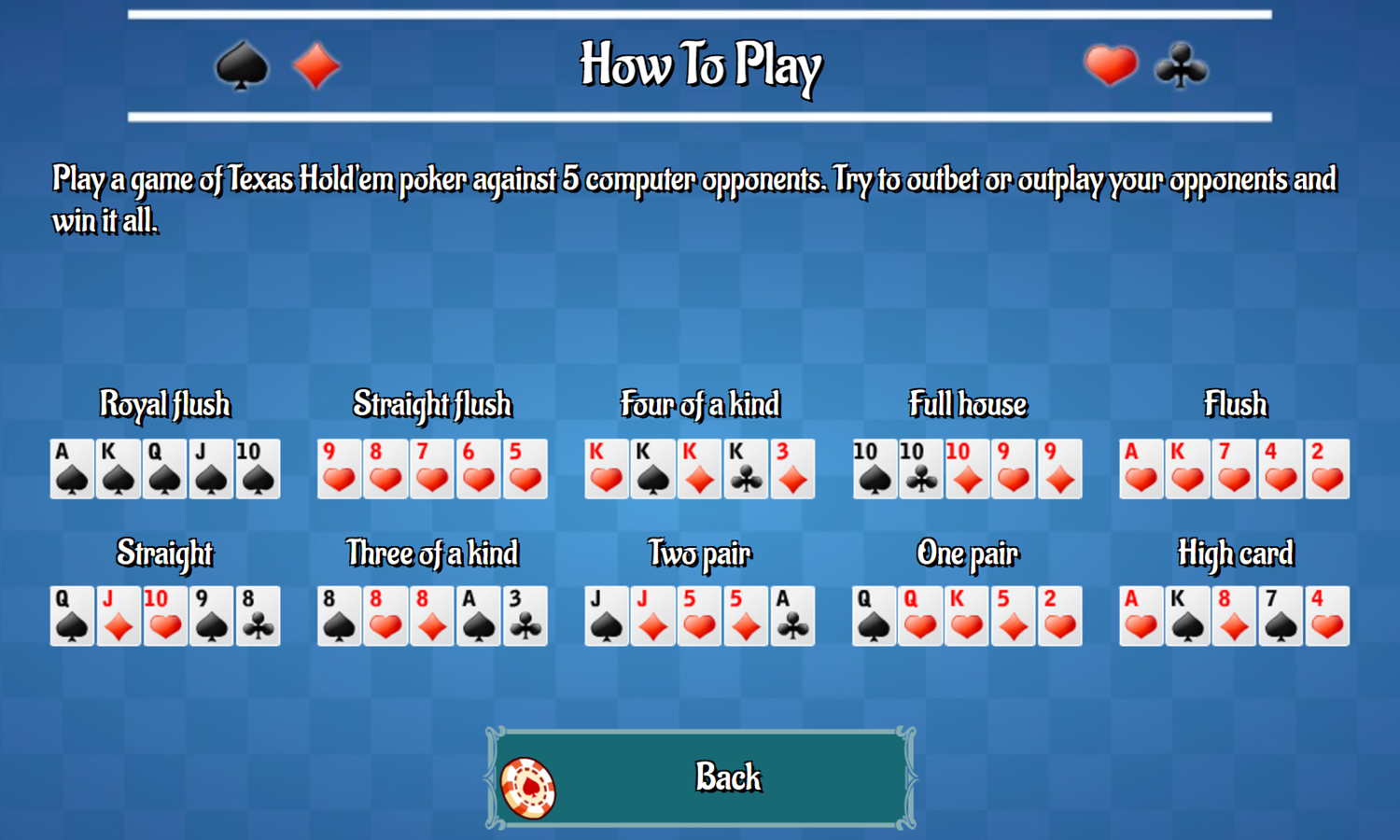
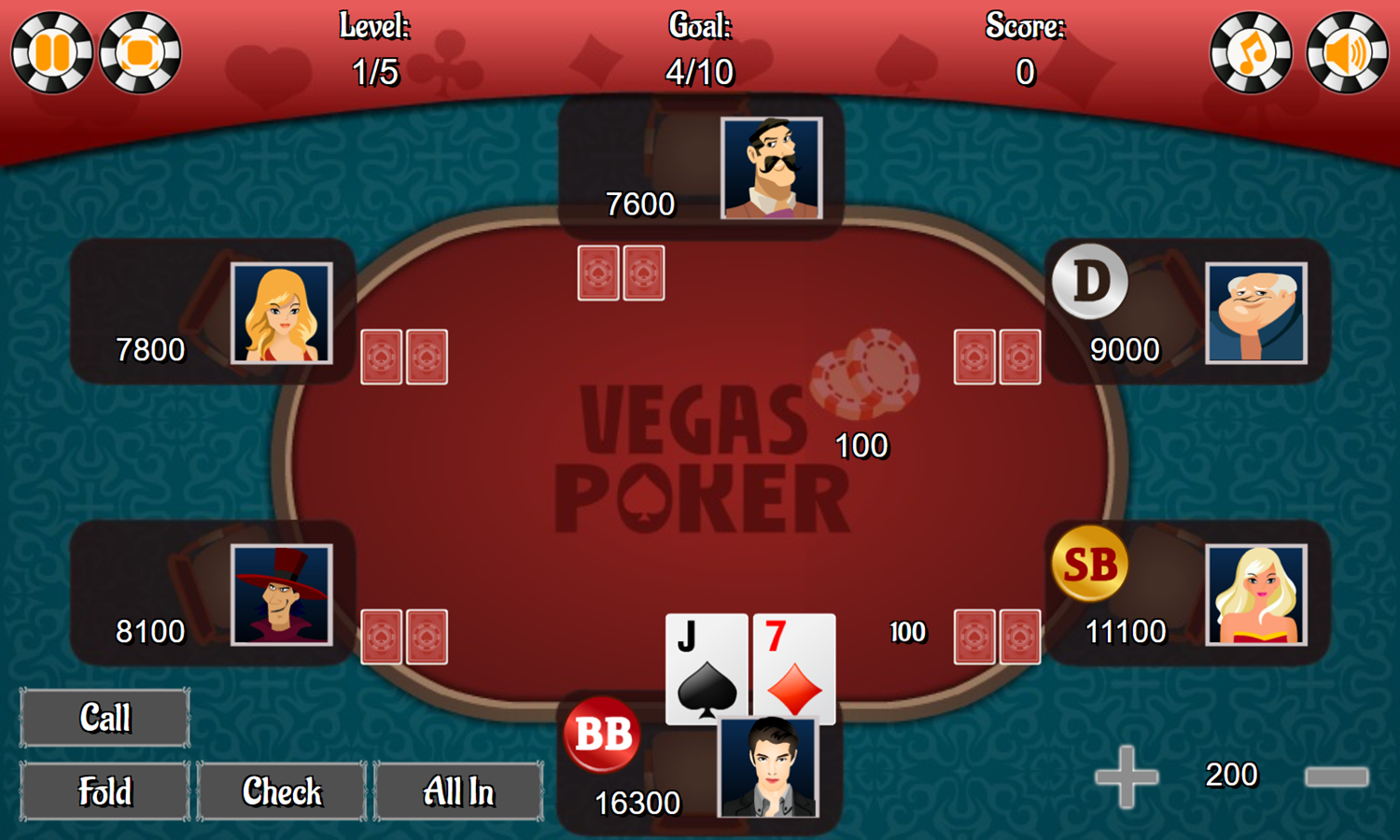
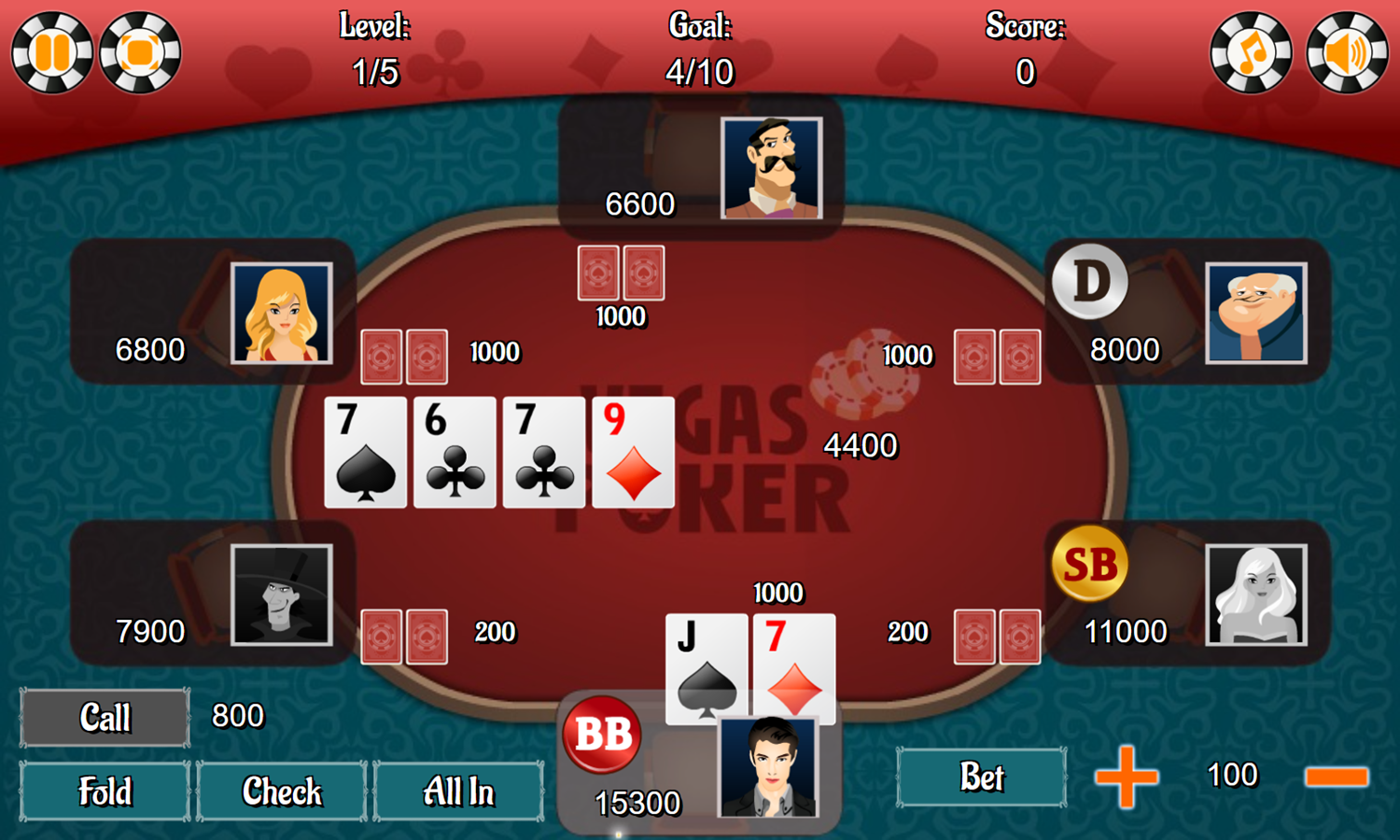
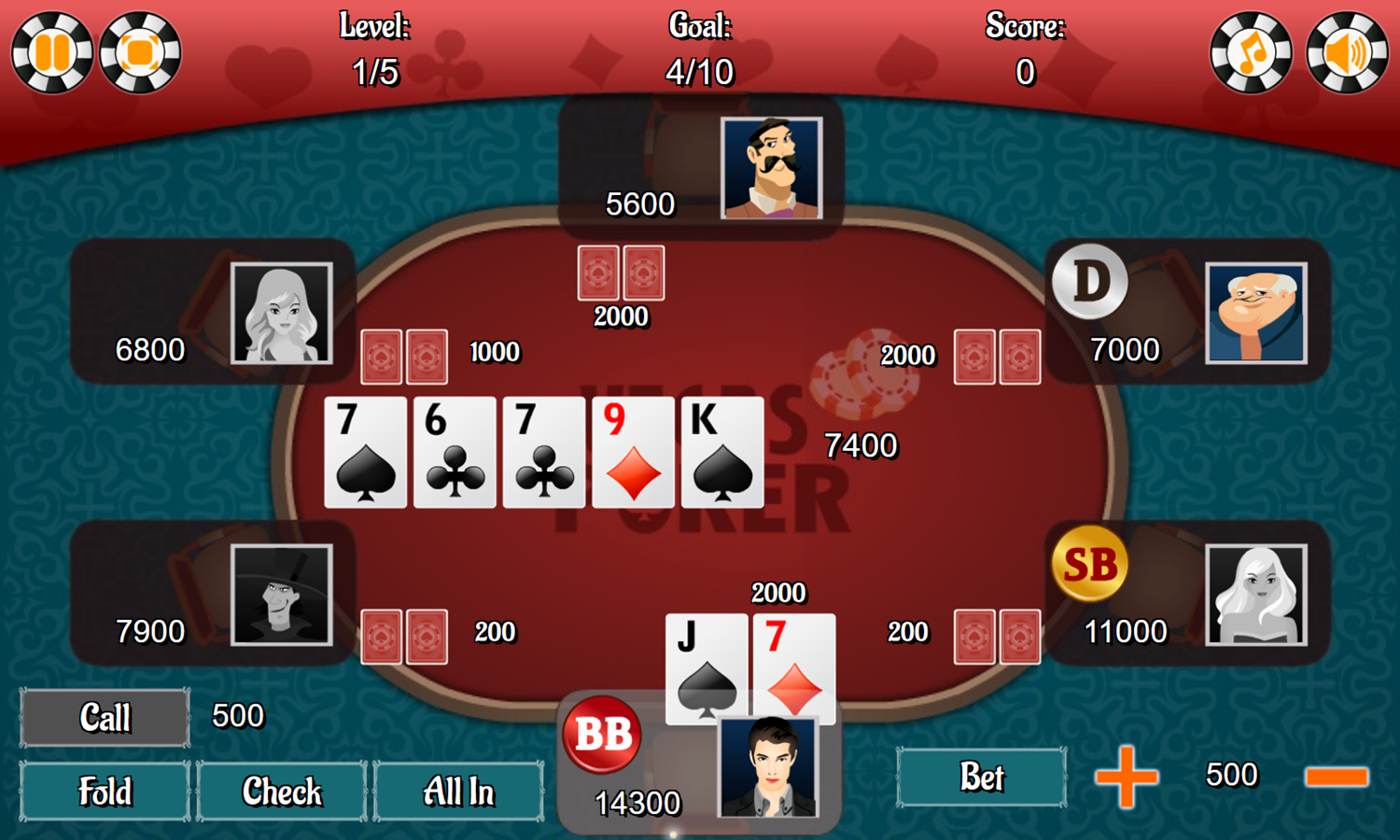
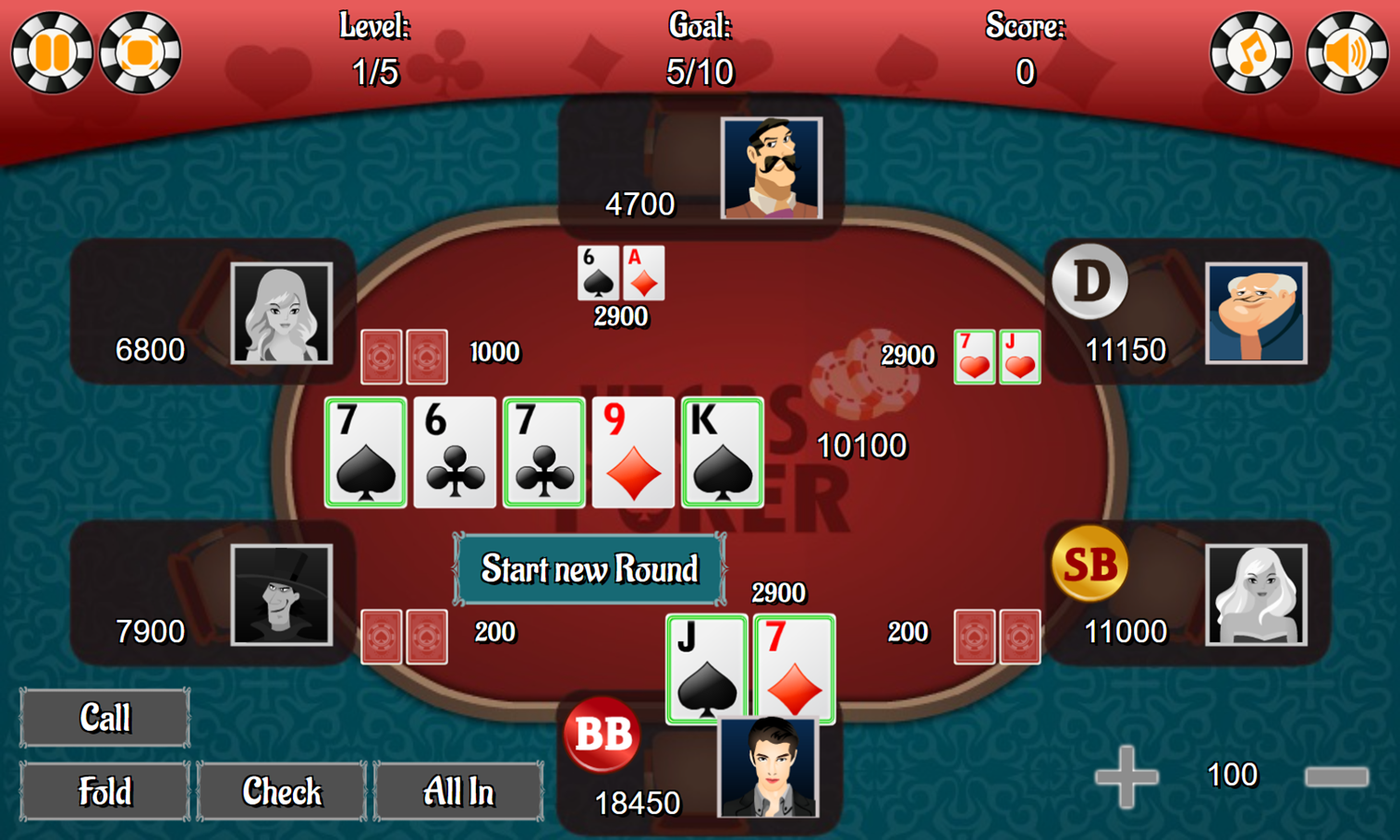
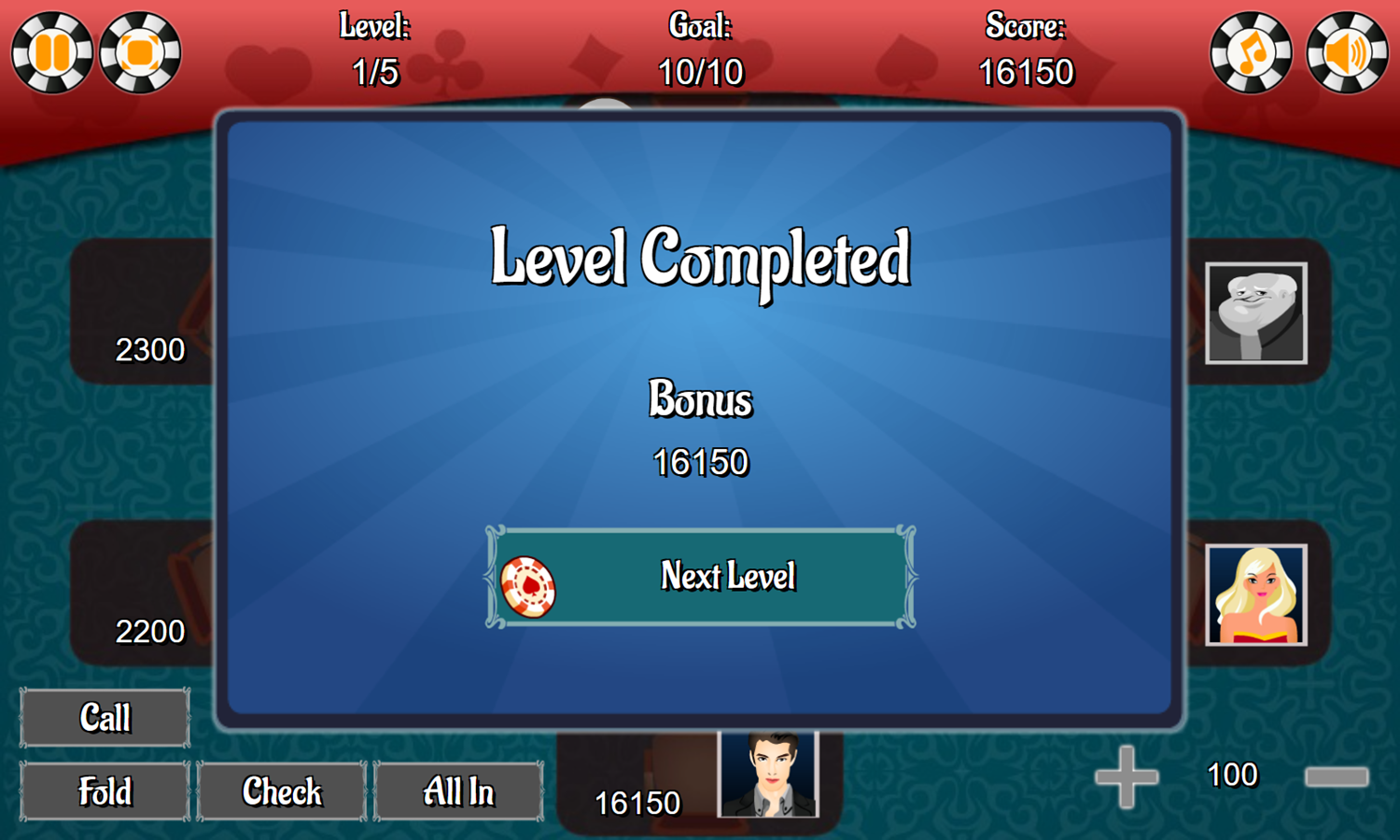
Mobile Friendly Cross Browser Support
This game is rendered in mobile-friendly HTML5, so it offers cross-device gameplay. You can play it on mobile devices like Apple iPhones, Google Android powered cell phones from manufactures like Samsung, tablets like the iPad or Kindle Fire, laptops, and Windows-powered desktop computers. All game files are stored locally in your web browser cache. This game works in Apple Safari, Google Chrome, Microsoft Edge, Mozilla Firefox, Opera and other modern web browsers.
Where To? What Next?
This game was published in these categories: Poker. You can visit any of them to select other fun games to play.
Our site hosts thousands of free online games. Check out the newest additions to our library or play a random game!
This game was published using our teamwide CardGames.pro account. If you have any comments, questions, concerns, or others (are there others even???) you can use the comments below to send along your 2 cents and help us improve the site further :) Your 2 cents plus 3 cents will buy you a nickel, but if your comments are genuinely useful and/or helpful and/or funny and/or memorable in a good way, we will probably say thanks :D

Search And Find And CardGames.pro Your Free Online Games :)



